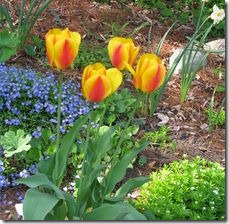Tulips are the showstoppers of spring in colors from fire-engine red to the purple-black of "Queen of the Night", from elegant pastels to the multi-colored parrot tulips. Parrot tulips have fringed and scalloped blooms, often with striking striations. It may not be easy to grow tulips if you have voles or deer visiting your garden. But growing tulips is worth the extra measures you may have to take. Here are tips on how to select and grow tulips and how to protect them from critters that love to eat them.
- Difficulty:
- Moderately Easy
Instructions
Things You’ll Need
- tulip bulbs
- trowel or tubular bulb planter
- bulb fertilizer or any fertilizer with relatively equal amounts of nitrogen, phosphorus and potassium
- Select and plant tulip bulbs. Select early, mid and late blooming varieties to have a long season of blooms. Bigger bulbs yield larger blooms, so choose high quality bulbs. Plant bulbs with the pointed part up and add bulb fertilizer at the recommended dosage to the garden bed or holes. Make sure that the soil drains well; tulips don’t like wet feet. Many tulips decline after the first year, because the bulbs multiply and less energy goes into blooms. Nurseries recommend to plant bulbs extra deep (at least 6-8 inches) to prevent multiplications or to lift them in late spring and store them in a cool and dry place until fall. Some people just plant new tulip bulbs each year. Alternatively, you can plant perennial tulips like the Darwin hybrids, which may come up stronger and more gorgeous for at least 3-4 years.
- Protect tulips from voles. It can break your heart to find wilted tulip leaves and about to open tulip blooms lying on the ground. Voles, mouse-like creatures with short tails, kill tulips because they eat the bulbs. Voles can also drill holes above the tulip bulbs in fall and winter and eat the bulbs at that stage. There are at least three effective methods to protect tulip bulbs from voles. 1)Use a vibrating or sonic "mole" chaser (it really chases voles). In contrast to the manufacturer’s claim, it probably only works effectively for a few feet surrounding the stake. Use a solar-powered or battery-operated one. 2) Add sharp stones or gravel to the soil. Voles don’t like sharp objects when they are digging. 3) Place bulbs in a wire basket with the top partially or completely closed. You can buy wire baskets or make them yourself. If the openings in the wire mesh are too big, voles may eventually tunnel in and if the openings are too small, the tulip leaves may become distorted when growing out. Another way to enjoy tulips and foil voles is to plant them in large terra cotta pots or planters on your deck or patio.
- Protect tulips from deer. Deer will eat tulip leaves as they emerge in spring. Use deer repellents when tulips are starting to come up. Deer repellents taste bad, smell bad or like "Deer-Off" do both. Repellents can be sprays, pastes, pellets or tablets. The tablets are systemic repellents that get absorbed by plants and can protect for up to 3 years. It is best to add tablets at planting time. For a natural look, dip pieces of branches in repellent paste and stick them in the ground next to your tulips.
Tips & Warnings
-
Don’t cut tulip leaves when tulips are finished blooming, the green leaves are needed to transmit energy to the bulb for next year’s blooms. It’s alright to cut the leaves once they turn yellow.
-
If you use deer repellent spray, repeat frequently or at least weekly.
-
Plant later blooming plants next to your tulips, so that they will hide the withering leaves.
-
Be aware that if you add bone meal to your tulip bed or hole, it tends to attract animal pests.


Deprecated: strpos(): Passing null to parameter #1 ($haystack) of type string is deprecated in /home/agriviek8Qv/agriviet.net/public_html/wp-includes/comment-template.php on line 2522